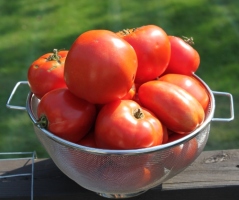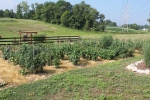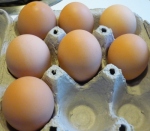How To Grow Amazing Tomatoes This Year!
28
Without a doubt – tomatoes are the most important crop we grow in our garden.
In fact, we use our home-grown tomatoes and tomato based products nearly 365 days a year. In the summertime – we eat them right off the vine, in salads, hamburgers, sauces and more. In the fall and winter months, we enjoy the tomato juice, vegetable soup, chili, salsa, pasta sauce, pizza sauce, and ketchup that we have canned or frozen from the summer’s bounty.
Here are some valuable hints, tips and tricks we have learned over the years to grow a bumper crop of tomatoes:
1. The When, How And Where Of Planting Tomatoes:
WHEN TO PLANT: Tomatoes are just about the last thing that get planted in our garden. Tomatoes love warm soil and warm weather. If you plant them too early in your growing season, they can really struggle. It’s not just about preventing frost. Cold, damp spring temperatures can make them more susceptible to disease, rot and lethargic growth. Here in this part of Ohio, most of our garden goes in around the 15th of May. If it’s nice and warm out – the tomatoes go in too. But if it’s still a little chilly and damp – we wait until late May to allow the soil to warm up!
HOW TO PLANT: Tomatoes benefit from rich, fertile soil. When you plant - make sure to add a few cups of good compost in the hole along with the plant. And start saving your eggs shells now! Crushed egg shells are an excellent supplement to add to your planting hole. They add calcium to the soil as they break down – helping to prevent the all-too common blossom rot; those black spots on the ends of tomatoes that can decimate a garden. We drop in a few crushed egg shells per planting hole.
WHERE TO PLANT: Plant your tomatoes in the sunniest location you can find. It can’t be said enough – tomatoes love sun and heat. The more you give them – the better your crop will be! And remember to rotate where you plant them from year to year – if you keep planting those tomatoes in the same spot, they will rob the soil of all the nutrients needed for great yields and become more prone to disease.
Mulching and Weeds:

Mulching around plants with compost gives the plants a boost and helps keep the area around your plants free of weeds
We mulch our tomato plants with a 1 to 2″ thick layer of compost – creating a 6 to 8″ compost circle around each stalk. It helps to regulate soil temperature, keep weeds to a minimum, and soil from eroding during strong rains. Of more importance, it acts as a slow-release fertilizer as nutrients strain through it during watering or rainfalls. Mulching also helps keep weeds at bay. Don’t let weeds compete for the same nutrients your tomatoes need. Just a few minutes of daily maintenance pulling small weeds around your plants will keep your garden productive and neat! Make sure as you work in your garden to stay off the ground directly around your plants – stepping on and around your plant’s root zone compacts the soil and keeps them from fully developing.
One last note on mulching. If the season and soil are still a little cool – wait a few weeks for it to warm up before applying the mulch. If the soil is still cool, mulching can actually prolong the soil from heating up.
Pruning and Supporting
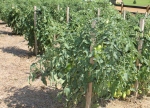
Pruning a few inches from the bottom of your plants allows for easy watering and increased air and light to reach your plants.
Whether you use cages, stakes, or a hybrid system like we do (See Stake a Cage), it’s critical to provide great support for your tomato plants! It keeps them off the ground – away from pests and foot traffic, allowing tomatoes to ripen with good circulation and exposure to sunlight.
As the plants grow during the first month – we like to prune out the bottom 3 to 4″ of stems and shoots. Why? It makes plants easier to water, and once again allows that all important air and light to circulate through the plants and rows. It also makes it a little more difficult for garden bugs and pests to find their way onto your plants.
Watering
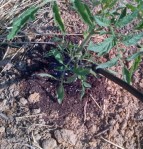
Water around the base of your plants, and not on the leaves. It allows water to reach the roots and prevents mold
Watering tomatoes (and for that fact, your entire garden), is as much about when to water, as it is how much. Never water during the heat of the day. Not only do you lose much of it to evaporation, but you also can easily burn the foliage of the plants. The absolute best time to water is in the early hours between sunrise and mid-morning. Not only is it cooler and easier on the gardener, but your plants are not stressing from the heat of the day either. Evening watering is your next best choice if you can’t water in the morning, although it can create mildew if the water sits on leaves through the cool nights.
How Much Water? This is a big one. When the plants are very young and for the first week or so, you may need to water daily to get them established. After that – watering every day is a no-no. Established tomatoes need about 1 inch of water a week. If mother nature can’t supply that - then you need to supplement. If you are experiencing a prolonged dry spell – water every two to three days with about a 1/2″ of water to the plant at a time. This allows enough water to go deep into the soil and create longer roots. Why not every day? Plants that get a little water every day never send their roots deeper to look for moisture and nutrients – and you end up with a weak root system, leading to a weak plant.
Soil Fertility and Fertilizing
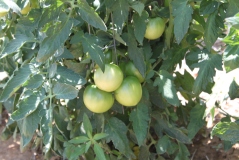
Good fertile soil leads to deep green and healthy plants. If you do want a little natural boost – try watering the soil with compost tea.
Tomatoes need fertile soil to grow strong and healthy. If you follow along with our blog, you know we’re not big fans of man-made fertilizers – so what is the answer when it comes to fertilizing? Well, if you use compost in your planting holes and as a top dressing, work in green manure and cover crops to your soil in the fall or spring, and practice plant rotation – there really is no need for synthetic fertilizers to get a great crop of tomatoes.
If you want to give your plants an all natural boost – you can apply compost tea – a simple solution of water soaked and steeped in fresh compost. The water absorbs the natural nutrients from the compost and becomes an “all natural” liquid fertilizer. We apply it to the soil around the base of our plants (not the leaves – it can burn them) a couple of times early in the growing season to get our plants off to a great start. (Well, truth be told, we also do it so our plants can look a little bigger and brighter than my brother-in-laws  ).
).
Happy Growing!
- Jim and Mary
